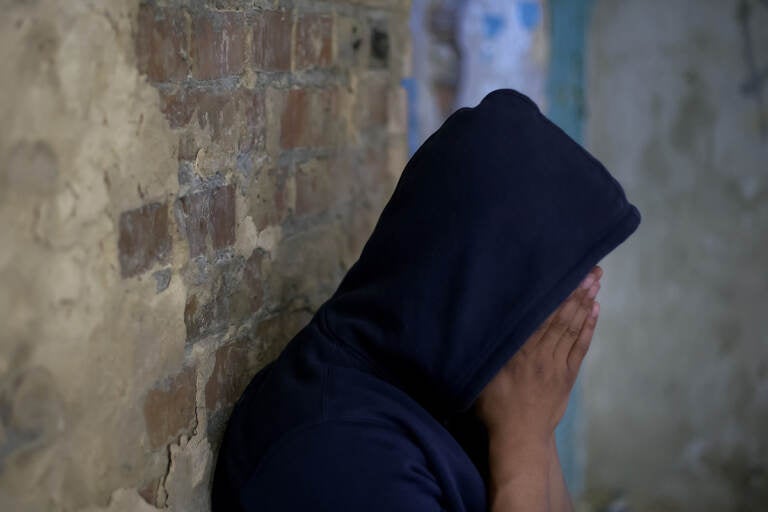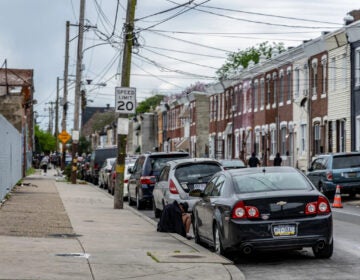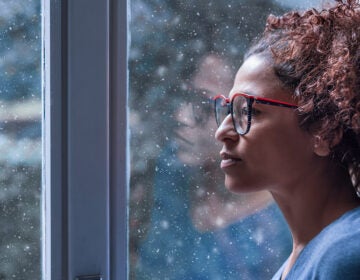‘We are in a state of emergency’: What's behind the rising suicide rate among Black kids
Today, suicide is the second-leading cause of death among Black children ages 10 to 19. And that rate is rising faster for them than for any other racial or ethnic group.
Listen 16:48
Today, suicide is the second-leading cause of death among Black children ages 10 to 19. And that rate is rising faster for them than for any other racial or ethnic group.(BIGSTOCK/motortion)
This story is from The Pulse, a weekly health and science podcast.
Follow The Pulse on Apple Podcasts, Spotify or wherever you get your podcasts.
It’s been a tough year for everyone — especially kids. Hospitals across the country have been reporting a surge in mental health crises among children. One children’s hospital in Colorado even declared a “state of emergency,” for pediatric mental health.
There are plenty of reasons this could be happening — from family financial stresses, to isolation caused by distance learning. But as you peel back the layers of what’s been happening with kids’ mental health, it becomes clear that the distress goes beyond the coronavirus pandemic. In fact, in a bombshell report released in September 2020, the Centers for Disease Control and Prevention announced that the rate of suicide among those ages 10 to 24 increased nearly 60% between 2007 and 2018.
Mental illness and suicide don’t affect all people equally. For years, experts have known who is most vulnerable — for example, suicide risk begins to rise sharply in adolescence. It affects boys more than girls, though girls make more attempts. And in terms of demographics, white young people far outpace almost everyone else (exceeded only by American Indian or Alaska native youth).
At least, that’s what experts thought they knew. For Arielle Sheftall, a principal investigator at the Center for Suicide Prevention and Research at Nationwide Children’s Hospital in Columbus, Ohio, the realization that something else might be going on — something beyond the conventional wisdom of who suicide affects — started in 2015 with a phone call.
“We were notified by a media outlet about a suicide death that had occurred in a younger child,” Sheftall said — a child of 11 or 12. “And the media outlet was wondering, has there been an increase in this younger age group? And to be quite honest, we weren’t sure.”
So Sheftall and her colleague — epidemiologist Jeff Bridge, who also directs the Center for Suicide Prevention and Research — downloaded some data from the CDC website to do an analysis and figure out whether there had been any increase in suicide among kids ages 5 to 11. At first glance, the answer seemed clear.
“No — there hadn’t been,” she said. “It was very flat.”
Until, that is, they brought race into the equation. That’s when they realized that, in fact, there were two very striking trends — ones that no one had noticed before. What they found was that among white kids ages 5 to 11, suicide rates had been declining. But among Black kids of the same age, they’d seen a steady rise. The reason no one had noticed before, Sheftall said, is because no one was breaking the data down by race — and when you removed that factor, the two trends canceled each other out.
“So he [Jeff Bridge] ran it like five times — again and again and again,” she said. “Because, you know, when you find a finding like that, it’s pretty eye-opening and your jaw drops.
It was a shocking revelation. It went against everything experts had been saying for years about how race affects suicidal risk.
Bridge, Sheftall, and other colleagues later solidified the findings in a 2018 paper that found that Black youth, 5-12 years of age, were approximately twice as likely to die by suicide than their white counterparts.
“Unfortunately, when you look at youth, suicide has been very white-centric, and the lens hasn’t really focused in on minorities and minority youth specifically,” Sheftall said. “So during that time frame, we kind of were like, ‘OK, well, what is really happening?’”
So Sheftall, along with NYU’s Michael Lindsey, and researchers Yunyu Xiao, and Sean Joe, decided to dig into the data and see what they could find out. This time, they looked at an older group — adolescents. They found that Black youth, both boys and girls, showed an increase in self-reported suicide attempts, and that Black males showed an increase in self-reported suicide attempts that led to injury.
Since then, Sheftall and other researchers have been trying to find out what’s causing the rise in depression and suicide among Black kids and teens — a problem that’s continuing to grow. Today, suicide is the second-leading cause of death among Black children ages 10 to 19. And that rate is rising faster for them than for any other racial or ethnic group.
(For more on these trends, see the Congressional Black Caucus’ 2019 report Ring the Alarm: the Crisis of Black Youth Suicide in America, tracking the rise in Black youth suicide, and racial disparities in mental health treatment.)
Though this trend has only recently attracted attention, it isn’t exactly new. According to Lindsey and Sheftall’s analysis of CDC data, the rise in suicide attempts among Black adolescents has been increasing since 1991 — rising a staggering 73% over the last 25 years..
“We have been dropping the ball, to be quite honest,” Sheftall said. “This change has been occurring, but we haven’t really noticed it until recently. And I really do believe we are in a state of emergency.”
Sheftall said the first step in addressing that emergency is realizing that it needs to be approached from “ground zero.”
“We need to really start at the very beginning,” she said. “We need to start at — OK, what are the risk factors? How do the risk factors look different? How do they look the same? What are the protective factors? What do those look like in Black youth specifically, compared to other youth of other racial and ethnic backgrounds?”
In other words, researchers need to forget what they think they know about what causes youth suicide and who is most vulnerable — because that conventional wisdom is, for the most part, based on research about white kids and teens. And, as the science is starting to show, Black youth suicide just isn’t the same.
“What does that look like in Black youth specifically?” Sheftall said. “And unfortunately, we’re finding that it’s not what we think it is.”
Discovering a child in crisis
For a lot of families, finding out a child is in crisis can come as a shock. For Lisa (who asked that we use pseudonyms to protect her family’s privacy), the news came via a group text from her sister. Her nephew, Jaden, who was 17 at the time, was in the hospital. His co-workers had noticed that he seemed out of it while working his part-time job.
“He was just, like, struggling to breathe,” she said. “And just completely out of it.”
At one point, he either nodded off or lost consciousness. So Jaden’s co-workers called 911.
Over at the hospital, the family found out that Jaden had overdosed on an opioid. That’s when it all came flooding out. Jaden admitted he’d been taking opioids since seventh grade — that he was depressed … and that he wanted to die.
“So that was the first kind of introduction that there was a major depression and suicidal thoughts with him,” Lisa said.
It’s something Lisa had never expected of her nephew, whom she remembers starting out as a little beam of sunshine.
“As a kid, he was very talkative, very outgoing,” she said. “He was just very bubbly and friendly.”
That started to change as Jaden got older. He became quieter — withdrawn, almost. But Lisa figured that was normal for adolescents.
“I just thought it was, like, that’s how you are when you’re a teenager,” she said. “You just have an attitude.”
Lisa said there were some family problems. She’d always felt that her sister’s husband was too strict, to put it mildly. But nothing that prepared her for this new reality: that Jaden was depressed, that he’d been depressed for years, that he had a five-year opioid addiction — and that he wanted to die.
At the hospital, Jaden was treated for the overdose, but as far as Lisa knows, was offered no mental health assessment, or recommendations, or follow-up.
Seeking help — and the impact of COVID-19
Over the past year and a half, plenty of families have experienced similar reckonings as they discovered their children were in crisis: questions not only of, “How did this happen?” but also, “What do we do now?”
Tami Benton, the psychiatrist-in-chief at Children’s Hospital of Philadelphia (known as CHOP), sees families like these every day.
“We have a large number of mental health providers at CHOP, and still we struggle to meet the demand,” she said. “And that’s true across the city.”
That was already the case before COVID-19 hit, Benton said, but the pandemic made things exponentially worse, both thanks to the shutdown of mental health programs and the added stress being placed on families and children.
They started seeing more kids — both kids who had already been struggling, and those for whom the struggles were brand new.
“We started to see kids who were pretty much well before the pandemic, who became overwhelmed,” she said, “due to the social isolation, the lockdown, the fear, the family stress, all the things that happened during the pandemic.”
The result is that CHOP, and children’s hospitals across the country, saw a major spike in mental health crises — more than a lot of them could handle. Benton said there just weren’t enough resources, resulting in parents’ widely publicized struggles to get help for their kids.
“More of those kids required hospitalization,” she said, “and that’s where the big problems have really, really stood out this past year … the long lines of kids waiting in the emergency departments for inpatient hospital beds.”
The waiting alone can be a trying — and, depending on the other patients who surround them, even a traumatic — experience, which discourages parents from seeking care.
The impact on Black families and barriers to help
The stressors affecting children and the barriers to treatment have been especially magnified for Black families. African Americans were hit hard by the pandemic, both in terms of their health, and their pocketbooks.
There have been other stressors over the past year and a half related more explicitly to race — for example, the murders of George Floyd and Breonna Taylor, which, thanks to social media, became inescapable for lots of kids.
But Black families haven’t just been facing unique problems, they’ve faced unique barriers to getting help.
Tami Benton said one problem is a lack of cultural competency among health care workers, which can make Black parents feel like they’re not being treated with kindness, understanding, or even respect.
She cited the experience of another Black doctor she knows who had brought her daughter to the emergency room. Immediately, the ER staff began questioning the mother about whether she’d ever been incarcerated, or ever had a drug problem.
“Before they even asked her all of the questions about her child’s mental health, those were some of the questions that she was being asked,” Benton said. “It felt incredibly disrespectful, and it compromised their trust from the beginning of the assessment.”
For some parents, that cultural gap translates into a feeling of alienation — even judgment, said Isha Metzger, a clinical psychologist who teaches at the University of Georgia and whose work focuses, in part, on reducing mental health disparities among African American youth and families.
“I think the two main things are, one, not being comfortable enough addressing the elephant in the room, and, two, not taking a parent’s culture and background into consideration,” Metzger said. “And somehow that being conveyed as, you know, parents feeling like they’re being told that they’re bad parents.”
“For example, if a caregiver says that they spank their kid, oftentimes what we as clinicians do is we tell caregivers the many, many reasons why we shouldn’t be spanking our kids and why that’s bad,” Metzger said. “What they’re going to say is, ‘Well, you obviously know nothing about me and my family.’ So what’s better to do is to ask caregivers about why they spank their kids.”
Clinicians, she said, should educate themselves about the history surrounding slavery, the fight for civil rights, and police brutality.
“The history that will lead Black parents to feel like they need to parent their kids more sternly,” Metzger said, “because they know that if they’re noncompliant or combative, or don’t respond to requests in society, that they can get beaten, that they can get shot by police, that they can get written up in school. So caregivers now are parenting their kids in a way for survival, right? So that’s a way that clinicians can say the wrong thing, or not necessarily ask about the values of a family that can lead them to think that, ‘OK, you don’t know how to talk to me,’ or, ‘You don’t know about my specific culture.’”
Subscribe to The Pulse
The lack of Black therapists
Lisa said that cultural disconnect came up when she was trying to get help for her nephew Jaden after his first trip to the hospital. She said the rest of the family had basically treated it like a stupid teenage mistake — a one-off. But over the next few months, Jaden overdosed again, and then again. Lisa tried to convince him to get into therapy. But she said his parents were reluctant.
“The first time he wanted to go to therapy, [his parents were] like, ‘You don’t want these white people to know that we have problems,’” Lisa said.
Another problem was Jaden didn’t feel much of a connection with the therapist.
“I really felt like he needed someone his own race and possibly even gender,” she said. “There was just a lot of disconnect, I think, between him and the therapist that they had chosen.”
This is a problem everywhere: Black Americans make up 13% of the country — but, as of the latest statistics, only 3% of psychologists.
“Finding black male therapist is like the hardest I think I’ve ever had to do in my entire life,” said Arielle Sheftall, the suicide researcher who helped uncover the rise in suicide among Black children. “That is a very low population of individuals, and finding them is really, really hard.”
While bigger cities might have more Black therapists, many places don’t.
“I think that that is, unfortunately, one of the biggest barriers … that we don’t have therapists that are, number one, culturally competent in the things that Black youth experience on a regular basis,” she said. “And I think that makes it harder for Black youth and their families to open up during therapy sessions and to be ‘real,’ so to speak, on what they’re thinking and what they’re feeling.”
Finding solutions
It’s only been a few years since researchers first recognized the rising suicide risk among Black youth — which means determining both the causes and the solutions is still a ways off.
But some experts have already started brainstorming changes that could make a difference. One of the first being simply recognizing when Black kids need help.
It might sound obvious, but it’s a step that happens a lot less often than you might think — in part, psychologist and researcher Isha Metzger said, because depression and anxiety often aren’t recognized in Black kids, at least not for what they are.
“We often see those Black youth who are suicidal, but we don’t see them as suicidal,” Metzger said. “We see them as deviant. We see them as angry. We see them as fill-in-the-blank in how we pathologize and label them. And I think that as early as we’re able to catch them and change them from those courses of actions, of thoughts, of feelings, then we’re able to prevent and intervene upon suicidality.”
Not only do adults need to recognize those red flags for what they are, experts said, they need to avoid the knee-jerk reaction of trying to punish Black kids for “acting out,” which can involve discipline at school — or worse.
“An individual can be showing signs of depression, and based on where they fall on a melanated scale, the reaction of society and community is definitely different,” said Mary May, a veteran relationship therapist and suicide prevention advocate in Philadelphia who works with both youth and families.
She added that especially when Black and brown people are experiencing a mental health crisis in public, “the police may be called, and handcuffs is the first way of resolving it.”
Another barrier to receiving mental health care is the deep-rooted stigma in many Black communities against mental illness and mental health care.
For years, studies have documented a prevalent belief in African American communities that suicide is a “white thing.”
“Throughout my years, I’ve heard that over and over again,” May said.
That stigma has created what May calls a culture of silence in a lot of Black families, one that can make it difficult for children to speak up about their emotional challenges.
“People who are of African American descent, or identify as Black American, are always on the edge of trying to show that they are worthy, in a sense,” May said. “And the prevalence of silence comes from a space of, we don’t want to make ourselves look bad, but we definitely don’t want to make whomever our caregivers are embarrassed.”
May said it’s essential for families to have more open conversations about mental health issues.
Another solution touted by experts is expanding education about mental wellness — both for kids and their parents.
“Simple things like social emotional learning curricula in the schools,” said CHOP’s Tami Benton. “Teaching kids how to express their feelings and how to talk about them; how to talk to trusted adults. And then being able to recognize when kids are struggling, and then have something you actually can do about it — because many providers will tell you, sometimes they know kids are struggling, but they don’t do anything because there’s nothing available.”
That’s something both Benton and researcher Arielle Sheftall have been working on: bringing programs to families who might otherwise not have the time or resources to get their kids help.
“Why can’t we go to them and actually do services where they are, versus having them always come to us all the time?” Sheftall said. “So I think we have to really change our mindset about the services that we are providing, and where we’re actually providing those services.”
Finally, there’s the aforementioned problem of cultural competency, or the lack thereof, which can destroy parents’ trust in health care providers and make kids less willing to open up.
Though increasing the number of Black clinicians would be ideal, Isha Metzger said there’s plenty white clinicians can do to connect better with Black clients — first and foremost being to acknowledge and confront racial differences head-on.
“If we’re unwilling to talk about race, racism, family, values, and culture, then our families are going to feel like, ‘OK, you’re only treating a very small percentage of my issues,’” Metzger said.
She added that therapists need to have the humility to admit when there are things about their clients — whether because of race or age — that they don’t understand. When in doubt, she said, ask questions.
“So I’m an expert in cognitive behavioral therapy — but I’m an adult,” Metzger said. “So I might say some things to you that let you know that I don’t really get what it’s like to be a teenager. If I say something that confuses you or offends you, or if you say something that confuses me, I want us to be able to talk about that, to ask questions, to say if you’re offended. I certainly want you to know that my intentions, however, are to help you and to really get to know you and your experiences.”
A light at the end of the tunnel
For Jaden, it was a long road to finding any kind of treatment that clicked with him and seemed to work. But finally, it happened — an inpatient clinic for young men that focused as much on therapy as it did on addiction treatment.
There was just one problem — the cost. Lisa doesn’t remember the exact figure, but her guess is that it was into the tens of thousands of dollars. Insurance covered some of it — the rest, Jaden’s mom had paid for.
“It was like her scrambling, taking money out of a 401(k), just to find extra money to cover the balance,” Lisa said.
In the end, it was just enough. In June, Jaden checked into the program for three weeks. And at first, it seemed like it was really helping.
“He talked to his mom, and his mom said he sounded a lot better,” Lisa said. “He sounded really positive.”
He was paid up through 21 days. Shortly before leaving, the facility told Jaden’s family they thought he needed to stay. And Jaden agreed — he said if he came back out, he felt he was just going to relapse. But his family didn’t have the funds to keep him there.
So after 21 days, Jaden came out and moved back in with his parents. Before long, the same arguments started happening. Soon, he relapsed. There was another hospitalization, another near-death experience. Eventually, Jaden decided that he just needed to get out — start fresh somewhere, someplace where everyone he knew wasn’t on drugs.
So he used the very last of his money to buy a plane ticket to go live with a friend in another city. And that’s what he was doing — living with his friend, working a low-paying job, trying to stay sober.
“He’s just working like a minimum-wage job for some reason,” Lisa said in mid-July, “and like staying at a hotel. So we don’t know what’s next.”
Lisa said the whole thing has been hard — not only for him, but for the whole family. She said it feels like a constant threat hanging over their heads.
“It’s just kind of feeling like I’ve been spinning my wheels, trying to just figure out how to best help him,” she said. “Because at the end of the day, his being alive is more important than anything else. So it’s taken over a lot of my life because I don’t want to slack on this and then something bad happens. So it feels like it’s do or die. We have to figure out a plan before something bad happens.”
But then came a flash of hope: The clinic where Jaden had been was offering him a scholarship to return, valued at $36,000.
Jaden went back and forth, but finally at the start of August, Lisa said, he had decided to go back. His life would be saved, at least for a while.
Support for WHYY’s coverage on health equity issues comes from the Commonwealth Fund.
WHYY is your source for fact-based, in-depth journalism and information. As a nonprofit organization, we rely on financial support from readers like you. Please give today.







